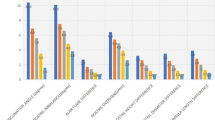Summary
In cleft lip and palate patients primarily the asymmetry of the nasal vestibules is conspicuous. Besides that there is always a septal deviation, which usually results in a deviated nasal axis. One experience gained between 1980 and 1989 on 274 cleft noses is presented. A new technique of nasal alar correction is described: After moulding of the cartilagenous framework, the soft tissue is corrected: The shortened cleft sided columella is prolonged by a triangular flap which is turned inwards. The surplus of skin of the overhanging ala is rolled in to achieve a symmetrical rim configuration. A resulting gap between these two flaps is covered by the surplus of vestibular skin.
Similar content being viewed by others
References
Anderl H (1985) Simultaneous repair of lip and nose in the unilateral cleft (a long-term report). In: Jackson IT, Somerlad BC (eds) Recent advances in plastic surgery, vol 3. Churchill Livingstone, Edinburgh, p 1
Bewarder F, Pirsig W (1978) Spätergebnisse nach submucöser Septumresektion. Laryngol Rhinol 57:922–931
Cottle MH, Loring RM (1948) Surgery of the nasal septum — new operative procedure and indications. Ann Otol 57:705–713
Cronin DTH, Denkler KA (1988) Correction of the unilateral cleft lip nose. Plast Reconstr Surg 82:419–431
Davis PKB (1983) Cleft lip nose tip deformity. Br J Plast Surg 36:200–203
Denecke HS, Meyer R (1964) Plastische Operationen am Kopf und Hals, Band I. Springer, Berlin
Dibbel D (1982) Cleft and nasal reconstruction. Plast Reconstr Surg 69:264–270
Egyeri P, Noormann MF, Van der Dusscen (1986) Eine Methode zur Nasenatmung bei Spaltträgern. Dtsch Z Mund Kiefer Gesichtschir 10:170–173
Erich JB (1953) A technique for correction a flat nostril in cases of harelip. Plast Reconstr Surg 12:320
Figi FA (1952) The repair of secondary cleft lip and nasal deformity. J Int Coll Surg 17:297
Fry HJH (1966) Interlocked stresses in human nasal septal cartilage. Br J Plast Surg 19:276–278
Goodman WS, Zorn ML (1982) The unilateral cleft lip nose. J Otolaryngol 11:198
Gubisch W (1988) Das schwierige Septum. HNO 36:286–289
14.Gubisch W (1989) Zum Problem der Spaltnasenkorrektur bei einseitigen Spaltbildungen. HNO 37:415–422
Gubisch W, Reichert H, Schuffenecker J, Widmaier W (1984) Ästhetische und funktionelle Wiederherstellung nach Nasentraumen durch Septumreplantation. In: Jungbluth KH, MommsenK (Hrsg) Plastische and wiederherstellende Maßnahmen nach Unfallverletzungen. Springer,Berlin Heidelberg
Jugo S (1987) Total septal reconstruction through decortication (external) approach in children. Arch Otolaryngol Head Neck Surg 113:173–178
McComb H (1985) Primary correction of unilateral cleft lip nasal deformity: a 10 year review. Plast Reconstr Sung 75:791–797
Murakami NT, Wong LW, Davidson TM (1982) Applications of the biomechanical behaviour of cartilage to nasal septoplastic surgery. Laryngoscope 92:300–309
Nakajiama T, Yoshimura Y, Kari T (1986) Refinement of the reserve-U-incision for the repair of cleft lip nose deformity. Br J Plast Surg 39:345–351
Nishimura Y, Ogino Y (1977) The use of two V-flaps for secondary correction of the cleft lip nose. Plast Reconstr Surg 60:390–394
Potter J (1957) Nasal tip deformities associeted with harelip. In: Transactions of the first international Congress of Plastic Surgeons, Stockholm. Williams and Wilkins, Baltimore, p 175
Rees TH (1986) Surgical correction of the severely deviated nose by extramucosal excition replacement as a free graft. Plast Reconstr Surg 78:320–330
Rethi A (1929) Über die korrektiven Operationen der Nasendeformitäten. I. Die Höckerabtragung. Chirurg 1:1103
Stenström SJ (1977) Correction of cleft lip nasal deformity: a refinement of an older method. Plast Reconstr Surg 69:675–679
Straith C, Straith R, Lawson J (1957) Reconstruction of the harelip nose. Plast Reconstr Surg 20:455–461
Strelzow V (1984) External septorhinoplasty approach to septal surgery. Facial Plast Surg 2:65–73
Tajima S, Maryama M (1977) Reverse U-incision for secondary repair of cleft lip nose. Plast Reconstr Surg60:256–261
Tolhurst DE (1983) Secondary correction of the unilateral cleft lip nose deformity. Br J Plast Surg 36:449–454
Uchida J (1971) A new approach to the correction of the cleft lip nasal deformities. Plast Reconstr Surg 47:454–458
Walter C (1976) Zur Korrektur der Spaltnase. In: Schuchardt K (Hrsg) Fortschr Kiefer-Gesichtschir XXI:254–258
Author information
Authors and Affiliations
Rights and permissions
About this article
Cite this article
Gubisch, W. How to obtain symmetry in a unilaterally cleft nose. Eur J Plast Surg 13, 241–246 (1990). https://doi.org/10.1007/BF00208323
Issue Date:
DOI: https://doi.org/10.1007/BF00208323




